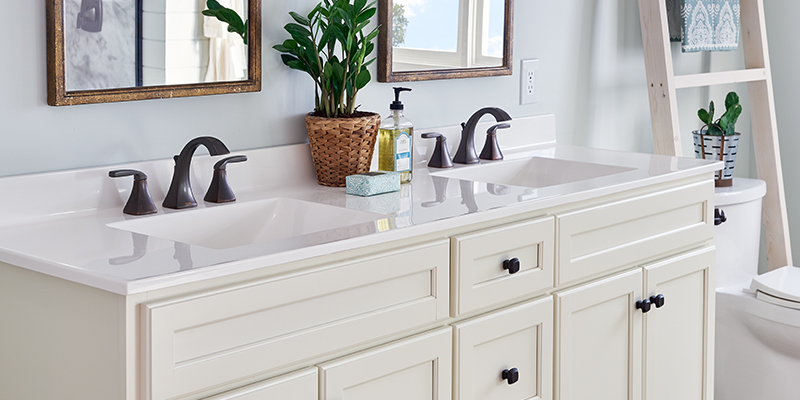Different Ways To Mix Metals in Your Bathroom
One of the questions our design consultants get the most when helping homeowners plan a bathroom remodel is, “Can I mix metal finishes, or do I have to stick to one?” The short answer is: yes, you can absolutely mix metal finishes in your bathroom! However, there are certain rules to follow when selecting multiple metals, such as how they complement each other, the way they will fit in with the rest of your home’s design, and which textures you should choose to accompany the other materials in the room. To help guide you in your decisions, here are our top six tips for mixing metals in the bathroom.
Design Tip #1 Cohesive Bathroom Design
The goal in an interior design project is for all of the elements in a space to come together and form a balanced whole. In mixing metals, design consultants recommend using no more than three. This allows you to make the space more visually interesting without making it seem cluttered. Another thing to keep in mind is that you don’t want to mix two metals in the same color family. If aged brass is one of your picks, steer clear of shiny gold – the two are similar in color but have different undertones and won’t look cohesive side-by-side. Two metals in one space that almost match can look like a mistake rather than an intentional design choice. When it comes to mixing metals, you want your choices to look deliberate.
Design Tip #2 Pick a Primary Metal for Bathroom
The primary metal you select for your bathroom should account for about two-thirds of the fixtures. Metals with a “cool” undertone are ideal for contemporary or transitional aesthetics: think brushed nickel, polished chrome, or stainless steel for sink and bath faucets, handles, shower heads and grab bars. If you prefer a traditional or rustic vibe, choose a base metal with a “warm” undertone, such as brass or bronze. If you want an of-the-moment design, look for hammered copper, antique gold, matte black steel, bright nickel, and natural iron – all trending right now.
Design Tip #3 Bathroom Accenting with Hardware
For the remaining third of fixtures in your bathroom, choose a metal that complements the tone of your base metal and your overall bathroom aesthetic. For example, a nickel accent can brighten a traditional bathroom, while matte black will amplify the sophisticated side of a transitional space. To balance the look, choose finishes with a similar hue, such as matching brushed nickel faucets with a matte brass mirror frame. How you incorporate your accent metal is up to you, but some common options include the knobs and pulls of vanity hardware, towel rings, lighting, mirror frames, shower trim, and accessories, such as soap dispensers or lamp bases.
Design Tip #4 Inspiration From Other Room Design
When deciding what tones to select for your primary and accenting metals, pull from other rooms in your home. For example, if your kitchen has a polished chrome faucet, consider choosing chrome as your bathroom’s primary metal. Let’s say your hallways have bronze light switch plates: in addition to having the same switch plate in your bathroom, you might also select bronze cabinet pulls and sconces to carry that metal from one space into the next.
Design Tip #5 Coordinate with Other Bathroom Materials
To achieve your goal of designing a well-balanced bathroom, let some of the other materials in the space influence the metals you choose. If you have a white birch vanity, for example, stainless steel hardware can help give the piece a distinctly modern flair. If you have a traditional vanity that’s made of a dark walnut, brass knobs would enhance its classic style.
Design Tip #6 Experiment with Texture in Bathroom Design
Don’t overlook the textural aspect when selecting metals for your bathroom. In addition to the typical finish options of matte or polished, modern metals can be brushed, burnished, antiqued, hand-rubbed, oiled, or hammered to add a whole new dimension to your fixtures. For example, the satin finish on a pair of brushed nickel faucet handles offers a cool, smooth tactile experience. A hammered bronze sink bowl, on the other hand, will cause water to flow in unique patterns toward the drain. No matter how you choose to incorporate it, texture is a great way to add a distinct sensory element to your bathroom. The only thing you want to avoid is choosing one metal in a variety of different finishes; this tends to look more like a mistake than a purposeful design choice.
The trend of mixing metals has been popular for a few years now and doesn’t show any signs of being replaced. But whether you can’t wait to try your hand at it, or are inspired to update your bathroom with a different style trick, our Design Consultants can help! Schedule your free in-home design consultation today. Interested in learning more about our five-step process? Click here.
